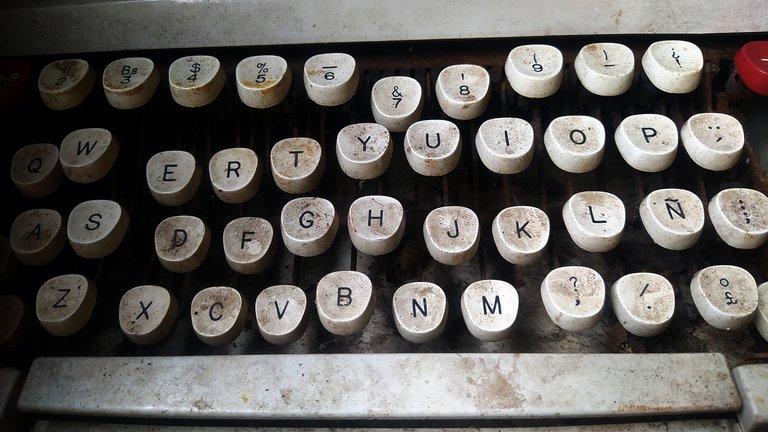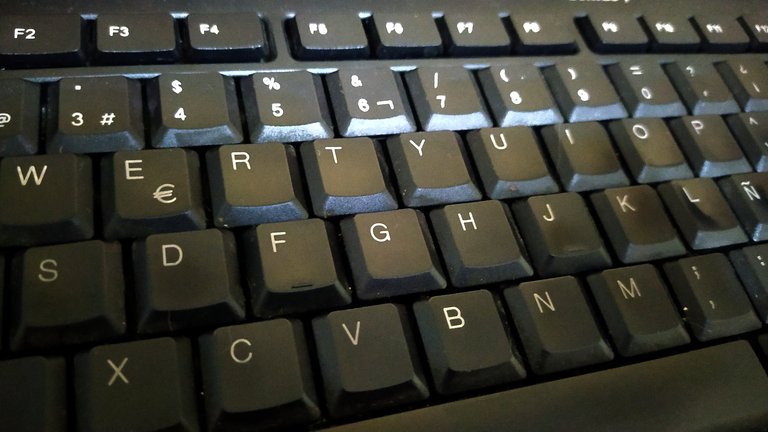When I entered the diversified cycle in my high school education, I did not know that I would see typing as an academic subject (by the way, I also saw calligraphy as a subject). But knowing this, I thought it would be a practical subject that I could perform in the workplace in the future, so I put my mind to it. So I put my mind to it. How were the teaching methods applied to us? And was it really useful? Please stick around for the answer.

Typing was one of the few subjects on campus that had its own classroom. It was on the top floor of one of the modules. It was a long, wide room, full of tables with old typewriters lined up in three columns. We students occupied them in the order in which we appeared on the class list. So since my last name begins with the letter "A", I was in the first row. That was the seat we would have for the rest of the class. That would be our machine, our table, our chair. It's like your parents picked who you're going to marry. Something like that.
Fortunately, the teacher was very teaching, kind and patient. That helped a lot for good learning. One of the first things we were taught were the "guide keys". That's the name of those specific keys where we placed the four fingers of each hand. We started by typing over and over again words that had only those eight letters. As the weeks went by, the textbook we used added letters that we pressed with a specific finger. Little by little, we knew which keys were pressed with which finger. Once we had been taught all of that, there were three tests of fire.
The first was a key memorization test. The teacher would give us a text that was placed on one side of the machine. She would stand on the other side and place a large folder between our face and our hands, blocking our view of the machine's keyboard. Then, we had to type the text, obviously, without seeing the keys.
The second was an effectiveness test, and measured how accurate we were and how much we were wrong. We used a stencil paper, which consisted of a set of papers of different compositions. The first one was a normal bond paper, followed by another one loaded with ink, which would "paint" the third paper with each stroke that would come from each keystroke. When we finished writing the test text, we had to separate the third paper and hand it to the teacher. Why the third one? Because it was impossible to try to erase any mistakes. The special ink would give us away. So the teacher would see how many wrong keystrokes we had made.
And the third was a speed test. The whole classroom had the same text to write. The teacher would set a timer and we would all start writing as fast as we could. At the end of the stipulated time she would shout, "Ya!" And we had to stop. Then she would do it a few more times. We would take the paper back and she would count the number of words we had written. It should be noted that only the ones we didn't make a mistake would count.

By the end of that year I could type on a keyboard without looking at it, just staring at the text I needed to copy or at the screen or paper I was typing. I was surprised recently when I reviewed my transcripts from those years and I passed that subject with 20 points, the maximum grade at that time. I didn't remember that particular detail. I guess I was helped by the fact that I mentioned at the beginning: I believed that I would put it into practice in the future. Did I succeed?
The truth is that I did. My first years of college I also worked at home doing transcription work and preparing different materials for students. It was a great advantage to write fast. I could finish long papers in less time, and I was not so afraid to take those that asked me to finish them in a short time. Of course, those cost more money.
When I started working as an administrative assistant, staff of an accounting firm and practicing as a certified public accountant, I could also apply it, filling out forms, tables and reports with good efficiency. Of course, it's even easier now, since computer keyboards are usually softer and smoother than the ones I learned on those old, hard and deep typewriters.
Now that I am writing blogs, the benefits are outstanding. I can type with good speed as the ideas come to me and I can move forward without worrying too much about where the letters I need are. Currently, on the free sites that measure typing speed and effectiveness I measure 56 words per minute and an effectiveness of 95%.

From my experience, I highly recommend that we develop this skill. For us, who are generating content, it will be very helpful if we are using our computers for that. If you have children, encourage them to do a simple course at home in their free time. I'm sure they won't waste any time. Thanks for making it this far, see you next time!



Cuando ingresé a el ciclo diversificado en mi educación media no sabía que vería la mecanografía como materia académica (por cierto, también vi caligrafía como una materia). Pero al saber ésto, pensé de que sería una materia práctica que podría ejecutar en el ámbito laboral en el futuro. Así que le puse empeño. ¿Cómo eran los métodos de enseñanza que nos aplicaban? Y, ¿de verdad me fue útil? Por favor, quédate para conocer la respuesta.

La materia Mecanografía era una de las pocas que había en el plantel que contaba con su propio salón de clase. Estaba en el último piso de uno de los módulos. Era un salón largo, amplio, lleno de mesas con viejas máquinas de escribir alineadas en tres columnas. Los alumnos las ocupábamos en el orden en el que aparecíamos en la lista de clase. Así que como mi apellido empieza por la letra "A", estaba en la primera fila. Ese era el puesto que tendríamos el resto del curso. Ésa sería nuestra máquina, nuestra mesa, nuestra silla. Es como si tus padres hubiesen elegido con quien te casarás. Algo así.
Afortunadamente, la profesora tenía mucha docencia, amabilidad y paciencia. Eso ayudó mucho al buen aprendizaje. Una de las primeras cosas que nos enseñaron fueron las "teclas guías". Así se llaman esas teclas específicas donde ubicamos los cuatro dedos de cada mano. Empezamos escribiendo una y otra vez palabras que tenían sólo esas ocho letras. Con el paso de las semanas, el libro de texto que usábamos iba agregando letras que pulsábamos con un dedo específico. Poco a poco, ya sabíamos qué teclas se pulsaban con cada dedo. Una vez que ya nos habían enseñado todo eso, venían tres pruebas de fuego.
La primera era una prueba de memorización de las teclas. La profesora nos daba un texto que se ubicaba a un lado de la máquina. Ella se colocaba al otro lado y colocaba una amplia carpeta entre nuestra cara y nuestras manos, tapando nuestra visión hacia el teclado de la máquina. Entonces, había que escribir el texto, obviamente, sin ver las teclas.
La segunda era una prueba de efectividad, y medía qué tan precisos éramos y qué tanto nos equivocábamos. Usábamos un papel stencil, que constaba en un juego de papeles de diferentes composiciones. El primero era un papel bond normal, seguido por otro cargado de tinta, que "pintaría" el tercer papel con cada golpe que vendría producto de cada tecla oprimida. Al terminar de escribir el texto de la prueba debíamos separar el tercer papel y entregarlo a la profesora. ¿Por qué el tercero? Porque era imposible tratar de borrar cualquier error. La tinta especial nos delataría. Así que el profesor veía cuantas pulsaciones habíamos hecho equivocadas.
Y la tercera era una prueba de velocidad. Todo el aula tenía el mismo texto para escribir. La profesora activaba un cronómetro y todos empezábamos a escribir lo más rápido que pudiéramos. Al final del tiempo estipulado ella gritaba: "¡Ya!" Y debíamos detenernos. Entonces lo hacía unas veces más. Retirábamos el papel y ella contaba el número de palabras que habíamos escrito. Cabe destacar de que sólo contarían aquellas en las que no nos hubiésemos equivocado.

Al terminar ese año podía escribir en un teclado sin verlo, sólo fijando la mirada en el texto que necesitaba copiar o a la pantalla o papel que iba escribiendo. Quedé sorprendido recientemente al revisar mis constancias de notas de esos años y tengo aprobada esa materia con 20 puntos, el máximo de nota en ese entonces. No recordaba ese detalle en particular. Supongo que me ayudó el hecho que mencioné al principio: creía que eso lo pondría en práctica en el futuro. ¿Lo logré?
La verdad es que sí. Mis primeros años en los que estudié en la universidad también trabajaba en casa haciendo trabajos de transcripción a computadora y preparación de diferentes materiales para los estudiantes. Era una muy buena ventaja escribir rápido. Podía acabar los trabajos extensos en menos tiempo, y tomar sin tanto miedo aquellos que lo pedían terminado en poco tiempo. Obvio, esos costaban más dinero.
Ya adentrándome en el trabajo como asistente administrativo, personal de firma contable y ejerciendo como contador público colegiado, también pude aplicarlo, al llenar formularios, tablas e informes con buena eficiencia. Claro, ahora es incluso más fácil, puesto que los teclados de las computadoras suelen ser más blandos y suaves que con los que aprendí, en esas viejas máquinas de escribir, duras y hondas.
Ahora que estoy escribiendo blogs, el beneficios es sobresaliente. Puedo escribir con buena velocidad, a medida que las ideas me van llegando y puedo avanzar sin preocuparme mucho en donde están las letras que necesito. Actualmente, en los sitios gratuitos que miden la velocidad y efectividad de la escritura en el teclado hago mediciones como 56 palabras por minuto y una efectividad de 95%.

Por la experiencia que he vivido, recomiendo ampliamente el que desarrollemos ésta habilidad. A nosotros, que estamos generando contenido, nos será muy provechoso si estamos usando nuestras computadoras para eso. Si tienes hijos, anímalos a que puedan hacer un curso sencillo en su propia casa en sus tiempos libres. Estoy seguro que no perderán el tiempo. Gracias por llegar hasta aquí. ¡Hasta la próxima!
😅

FUENTES / SOURCES
Cover: Made with the free version of CANVAS || Portada: Hecho con la versión gratuita de CANVAS
Images: Shot with my Xiaomi Redmi Note 8 phone and edited with GIMP || Imágenes: Realizadas con mi teléfono Xiaomi Redmi Note 8 y editadas con GIMP
Banner: Made by me in GIMP with my own images and free resources from the site pfpmaker.com/ || Banner: Hecho por mi en GIMP con imágenes propias y recursos gratuitos del sitio pfpmaker.com/
Language: Post written in Spanish and then translated into English through DeepL || Idioma: Post redactado en español y luego traducido al inglés mediante DeepL
Posted Using InLeo Alpha

